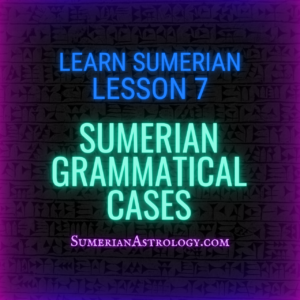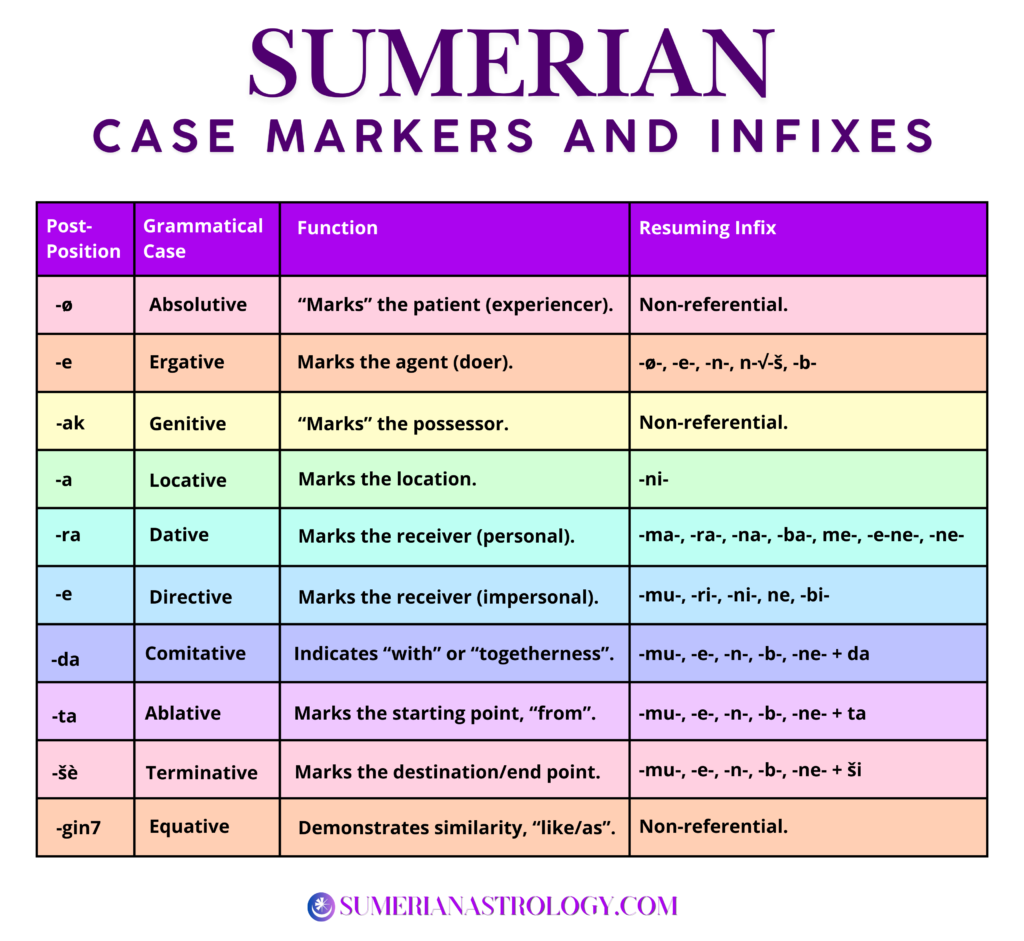Lesson 7
Sumerian Grammatical Cases
In this lesson, you’ll be introduced to the Sumerian grammatical cases. We’ll be covering each of the cases in their own separate lessons, so don’t feel like you need to memorize them yet!
Helpful Terms
If you’re new to language-learning, this list of helpful terms may seem overwhelming at first, but you’ll see these often, so don’t worry about memorizing them now! I just wanted to list them out so you can start familiarizing yourself!
- agent: the noun in the sentence that performs the action.
- case marker: a particle suffixed to a noun to indicate the role it plays in a sentence; also called a postposition.
- grammatical case: is a grammatical category which helps identify the role of a word in a sentence.
- ablative (abl.): indicates removal or separation from; can also indicate manner or method, marked by -ta 𒋫.
- absolutive (abs.): the standard, unaltered case of a noun.
- comitative (com.): indicates group action, as in ‘with’, marked by -da 𒁕.
- dative (dat.): indicates motion toward someone, as in ‘to/for [a person]’, marked by -ra 𒊏.
- directive (dir.): indicates motion toward something, is in ‘to/for [a thing]’, marked by -e 𒂊.
- ergative (erg.): indicates the agent; the noun doing the action, as in ‘[performed] by’, marked by -e 𒂊.
- equative (equ.): indicates similarity, as in ‘like’, or ‘as’, marked as -gin7 𒁶.
- genitive (gen.): indicates possession, belonging, or origin, as in “of”, marked by -ak 𒀝.
- locative (loc.): indicates where something is happening, as in ‘in’, or ‘at’, marked by -a 𒀀.
- terminative (term.): indicates a final destination, as in ‘to [a place]’, marked by -šè 𒂠.
- patient: the noun in the sentence that experiences the action.
- postposition: a particle suffixed to a noun to indicate the role it plays in a sentence; also called a case marker.
Vocabulary to Memorize
I highly recommend memorizing these Sumerian words, as you’ll encounter them often in the upcoming lessons!
- dumu 𒌉 n., child, son, daughter.
- iri 𒌷 n., city, town, village, district.
- nin 𒎏 n., lady, mistress, owner, queen; lord (sometimes found in male names).
Vocabulary--Full List
Here are the vocabulary terms for this lesson. Be sure to look them over as they’re updated with additional meanings each lesson. You can see the full Sumerian Lexicon here.
- a 𒀀 n., water, semen, progeny, canal, flood. part., in, at, when; nominalizing suffix.
- ak 𒀝 v., to do, act; make into; place. part., of (gen.).
- da 𒁕 n., arm; edge, line; near, close. v., to be near, hold, protect. part., with (com.).
- dumu 𒌉 n., child, son, daughter.
- e 𒂊 v., to speak, say; do; water. part., [performed] by (the agent); in, at, beside.
- é 𒂍 n., house, temple.
- gin7 𒁶 part., like, as, just as; instead of; during.
- iri 𒌷 n., city, town, village, district.
- lugal 𒈗 n., king; owner, master, lord.
- nin 𒎏 n., lady, mistress, owner, queen; lord (sometimes found in male names).
- ra 𒊏 v., to accompany; bear; drive; go; lead; multiply; mix, stir. part., to/for (pers.)
- šè 𒂠 n., portion. part., to(ward); they/them; adverbial suffix.
- ta 𒋫 part., away from (abl.); out of; after, since; by means of (abl.).

Sumerian Grammatical Cases and Markers (Postpositions)
A grammatical case is a category which helps identify word’s role in a sentence.
In Sumerian, the role a word plays in is often identifiable by something called a case marker, which is suffixed to the word.
These postpositions indicate relationships between nouns in the same way prepositions do in English.
We’ll be discussing the Sumerian grammatical cases in depth in subsequent lessons. For now, take a look at the following case markers, and how they operate in a sentence.
Case Marker Summary
Generally speaking, there are 10 Sumerian Grammatical Cases.
For the most part, the appropriate case marker is suffixed to a noun, although there exceptions, which we’ll discuss in later lessons.
Be aware that the absolutive case is unmarked, or said to have a ‘zero ending’ (-ø).
- -ø ‘zero ending’—absolutive case (abs.)
- -e 𒂊 [performed] by—ergative case (erg.)
- -ak 𒀝 of—genitive case (gen.)
- -a 𒀀 in/at—locative case (loc.)
- -ra 𒊏 to/for—dative case (dat.)
- -e 𒂊 to/for—directive (dir.)
- -šè 𒂠 to/toward—terminative case (term.)
- -da 𒁕 and/with—comitative case (com.)
- -ta 𒋫 from/by means of—ablative case (abl.)
- -gin7 𒁶 like/as—equative case (equ.)

Case Marker Breakdown
The following represents a breakdown of the Sumerian grammatical cases and their markers, with some examples. Again, don’t be intimidated! We’ll cover each of these in detail, in upcoming lessons!
- -ø ‘zero ending’—absolutive case (abs.)
- indicates the patient; that is, the noun experiencing the action.
- -e 𒂊 [performed] by—ergative case (erg.)
- indicates the agent; that is, the noun performing the action
- lugal-e 𒈗𒂊 by the king
- indicates the agent; that is, the noun performing the action
- -ak 𒀝 of—genitive case (gen.)
- indicates possession
- nin[-ak] 𒎏[𒀝] of the queen (alt. the queen’s)
- here, -ak 𒀝 is in brackets because it doesn’t appear unless followed by another word
- nin[-ak] 𒎏[𒀝] of the queen (alt. the queen’s)
- indicates possession
- -a 𒀀 in/at—locative case (loc.)
- indicates the noun’s location
- é-a 𒂍𒀀 in the house/temple
- indicates the noun’s location
- -ra 𒊏 to/for—dative case (dat.)
- indicates who the action was done to/for (personal nouns only)
- nin-ra 𒎏𒊏 to/for the queen
- indicates who the action was done to/for (personal nouns only)
- -e 𒂊 to/for—directive (dir.)
- indicates what the action was done to/for (impersonal nouns only)
- iri-e 𒌷𒂊 to/for the city
- indicates what the action was done to/for (impersonal nouns only)
- -šè 𒂠 to/toward—terminative case (term.)
- indicates direction or destination
- iri-šè 𒌷𒂠 to/toward the city
- indicates direction or destination
- -da 𒁕 and/with—comitative case (com.)
- indicates who an action was done with, or the conjunction ‘and’
- lugal nin-da 𒈗𒎏𒁕 the king and queen (lit. king queen-with)
- indicates who an action was done with, or the conjunction ‘and’
- -ta 𒋫 from/by means of—ablative case (abl.)
- indicates place of origin or methodology
- iri-ta 𒌷𒋫 from/by means of the city
- indicates place of origin or methodology
- -gin7 𒁶 like/as—equative case (equ.)
- indicates similarity or likeness
- dumu-gin7 𒌉𒁶 like a child
- indicates similarity or likeness
Your Sumerian Language Journey Continues!
Congratulations! You’ve just learned one of the most important parts of the Sumerian language! You’ll be speaking and translating ancient Sumerian in not time! In the next lesson, you’ll learn about word-order in Sumerian sentences, so be sure to subscribe to my substack to get notified as soon as it posts!


